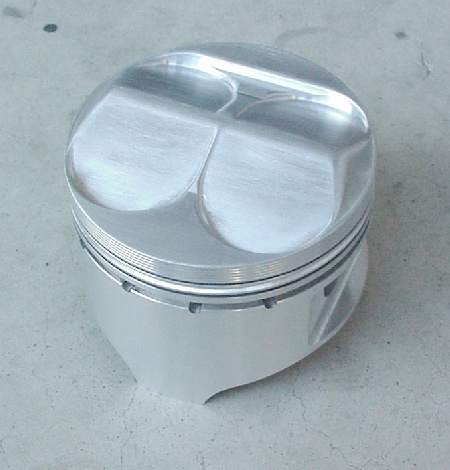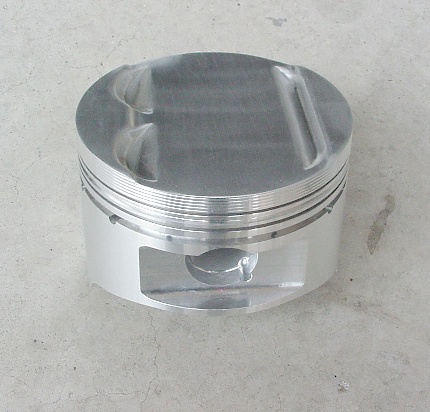An Intro to Roller-Wave Pistons
The company that's defined the leading edge of combustion
technology for high-performance engines over the past 25 years has been at it
again.
We've spared no expense to bring Honda enthusiasts the very
finest specialty pistons available anywhere for both normally aspirated,
supercharged, and turbocharged applications. These pistons are identical to
those we use in our in-house engine programs. They come complete with crowns
that are machined to the application's specs and hand finishing.
We chose Wiseco Piston, Inc. to forge and machine the
piston's basic configuration, including skirt, ring lands, and basic crown
shape. Wiseco has been making pistons to our specifications since 1960, and
aside from our long relationship, their experience in making small bore,
4-valve, high-RPM pistons was a primary consideration in their selection for
our program.
Roller-Wave?
As many of you know, Endyn has been involved with the
science of mixture flow and combustion technology since it's beginning in
1974. Our forward thinking and willingness to "do-whatever-it-takes"
has put us in the company of many industry powerhouses over the years enabling
us to compile an enviable list of successes and historical "firsts."
Two of Endyn's "firsts" include pioneering efforts
in both "biased" burning and "swirl" combustion
technologies for use in high-performance applications. Documentation shows
that we were, at times, so far ahead of our peers, that they all claimed that
the sciences couldn't even work. Well, we've stood the test of time, and now,
the rest of the industry is actively using technologies that they all
"damned" fifteen years ago, when first defined them.
We've been studying and working with multi-valve (four, or
more valve) combustion chambers for more than twenty years and with the aid of
the latest modeling advances, we've identified a few new ways to
significantly improve (and control) the combustion event in many of the
"pent-roof" style combustion chambers that have become so popular
today.
During experiments using various piston shapes that served
to "push", or "squeeze" the cylinder's mixture from one
side of the combustion chamber to the other, we found that by manipulating the
piston to cylinder head clearances, a pressure pulse, or wave could be created
that would define the actual combustion event. By "pushing" the
pulse away from the intake side of the combustion space, we were able to
increase the burn speed and efficiency enough to make significant increases in
power with less attendant tendency for the occurrence of detonation. This
design concept was originally offered as the "Enhanced Combustion"
series of pistons, which were a tremendous advance in piston technology. In a
marketplace dominated with pistons produced by manufacturers making
"generic" shapes, our "leading edge" configurations
quickly became the choice of discerning enthusiasts and pro-engine
builders.
Not being a company that's ever rested on our laurels,
considerable research continued in efforts to make something "good",
even "better." Since we were dealing with a wave traveling across
the piston, we surmised that perhaps a shape could be created between the
exhaust side of the combustion chamber and (that) side of the piston, which
would reflect the wave back across the piston to the intake side, providing
more burn efficiency yet. Experimental pistons were produced that used a
"reflector" shape that, when combined with the intersect of the
sloping chamber and flat exhaust side quench pad, served to reverse the
direction of the combustion wave.
Configuring and positioning the "reflector" to
work (on-time) with the wave produced by the quench intersect on the intake
side proved to be a formidable task, especially considering the additional
volume it represented. We were able to combine the "reflector" with
the exhaust valve pockets, or reliefs on several of the piston designs,
enabling us to minimize both surface area and volume increases. On the
normally aspirated, high-compression pistons, we even added a
"tongue" to the reflector, helping provide a secondary
"push" to the reflected wave on some engines' pistons.
Now, where did the "roller" come from? When viewed
from the side (through the engine's center axis), the combustion event appears
to roll across the piston, first from the intake side to the exhaust, and then
back again. Several of us felt that the observed "rolling-wave"
should be incorporated in this piston style's name. Technically, they're still
part of the "Enhanced Combustion" series, but they're of the
"Roller-Wave" configuration.
These pistons are, like their predecessors, made from
premium alloys designed to provide low expansion and life-cycles well beyond
those of any other pistons available. The forgings are precision machined on
the most accurate equipment available to provide the closest tolerances
(piston to piston, and set to set) of any pistons from any manufacturer. All
pistons come pin-fitted and can be used with pressed, or full-floated
connecting rods.
Below are some pictures of the pistons for some of the Honda
engines. We have pistons that are application-specific, for both normally
aspirated and turbo-supercharged engine types. I'll attempt to point out some
of the features of the pistons below their pictures. Stay tuned, these pistons
will end up being the most copied pistons in the history of the
industry.

Take a good look....this is our high
compression, normally aspirated piston for the B18C1 (GSR) engine. Notice the
carefully shaped dome configuration that's been developed using the extensive
computer modeling, flow bench validation, and dyno testing. There are no
sharp, faceted angles, or intersects to interfere with mixture travel or flame
motion.
Think about those sharp edges on other brands of pistons and
consider the fact that the piston is the floor of the combustion chamber.
Don't cylinder head specialists remove sharp edges from the combustion
chamber? Then, why would you use a piston that negates of all that chamber
smoothing?
We don't have an assembly line spitting out pistons here. So
the hand-finishing is accomplished by engineers who prepare the pistons that
go in our customer and project engines. There are no unqualified
"paid-by-the-set" people involved in any part of the preparation and
inspection process.
The exhaust side "reflector" can be readily seen
traveling across the piston, along with the secondary reflective
"tongue."
On the intake side, look carefully and you'll see the slight
"edges" that define the intersect of the valve reliefs' intersect
with the dome at the cylinder walls. They're only about .110" long, so
look carefully. Their combination with our unique "fence" that
separates the two intake valves on the dome serve as guides for the intake
flow at low lifts. They also serve to "spoil" inert exhaust gasses
attempting to enter the intake side during overlap.
Other features include significant oil return hole exposure
beneath the oil ring land and the inclusion of multiple detonation grooves
above the top compression rings.

Here's a B-20B/Z piston that's been designed and machined
for a turbocharged application. The compression ratio this piston yields is
approximately the same as that of a stock B20 unit from Honda.
If you notice, there's a slight depression that extends
across the center portion of the piston. This lowered area extends
approximately to the points where the quench pads of the cylinder head meet
the slope of the combustion chamber on both the intake and exhaust sides.
We've designed the piston this way to maximize the quench, or (artificial
octane) that's available with the existing Honda cylinder head geometry. This
is an important feature, as it substantially reduces the engine's octane
dependency, increasing tolerance for detonation.
The reflector on the exhaust side of the piston also
incorporates the exhaust valve reliefs, substantially lowering overall crown
surface area. As with the higher compression pistons in the series, the
reflector, in combination with the active quench pads, creates a much more
complete combustion process at lower temperatures than with
"generic" pistons of the same compression ratio.
This type of piston is also available for those desiring to
improve the combustion characteristics (make more power) with normally
aspirated engines, while maintaining stock compression rations.
Note that all these Roller-Wave pistons have piston ring
placement and grooves tailored to prevent damage from detonation, should there
be malfunctions in the ignition or fuel systems under load. This style piston
is also made to order and hand finished.
Apples and Apples?
Never before has there been a time, when so many enthusiasts
have had so much engineering data available at their fingertips. As a result,
the average racer today possesses far greater understanding of all the nuances
of internal combustion engines, and (he) is better equipped to make decisions
regarding component selection for his engine's application.
We're offering a visual comparison to permit engine builders
to see the actual differences between our new Roller-Wave pistons and those
produced by "other" manufacturers. We frequently refer to these
other pistons as "generic" in design and I think you'll see why.
What companies manufacture "generic" pistons? I'll leave that
decision up to you, but Endyn doesn't.

In the picture above, you'll see a "generic" style
piston for a Honda B18C1 (GSR) application on the left and you'll see the
Endyn Roller-Wave piston for the same engine on the right. Both designs are to
be used in a forced induction application, turbocharged in this particular
instance.
Of particular importance, note that the depression in the
top of the Roller-Wave piston isn't as deep as that in the "generic"
unit, so the mechanical compression ratio is designed to be a bit higher for
more power production. The depression in the generic piston is of a round
configuration, rather than one designed to interact with the combustion
chamber.
The overall surface area of the crown of the
"generic" piston is also greater than the Roller-Wave and all engine
builders agree that this area should me minimized for maximum performance.
You can also see that we've extended the point of skirt
contact with the cylinder wall down lower than the "generic", to
prevent excessive piston "rocking", minimizing attendant cylinder
wall and ring wear under high stress conditions. Our oil return holes are also
placed to maximize oil return to the crankcase, with more area placed beneath
the lower ring rail.
While not visible in these pictures, we've also incorporated
a total of (4) ring-pressurized piston pin oiling ports, with two per side for
improved pin lubrication.

In this view, the two pistons are placed on a B18C1 (GSR)
cylinder head to show the combustion chamber shape they're intended to work
with.
On the cylinder head, please note the flat quench areas that
are at the top (exhaust side) and at the bottom (intake side) of the
combustion chamber.
Now, take a good look at both pistons. It should first be
evident that the "generic" piston hasn't been designed with anything
in mind except the valve placement. The Roller-Wave piston, has a quench
pad on both the intake and exhaust sides that perfectly matches those areas in
the cylinder head. Coincidence? Luck? I don't think so.
You've heard the old saying about a picture being worth a
thousand words before. I suggest that this picture is worth a lot more. I've
previously predicted that the Roller-Wave concept will ultimately be the most
copied in the industry, and if you look at the pictures and understand the
dynamics involved, the reasons are obvious.
While the rest of the industry's been satisfied with the
"status-quo", Endyn's released two high tech piston designs in a
single year...all at pricing that's the same of less than the
"generic" slugs. Hang on, because there's a lot more coming.
- The Old One
For additional info about combustion space and our
design philosophy, read The
Soft Head 1999.